Early Christian Symbolism on Roman Coins.
Return to the main page. Return to Table 1 on the main page.
Coins of Table 1: Period of Constantine, to his death in to 337.
Images are all proportional to their actual size.
Skip down to Type 1.5, 1.7, 1.8, 1.9 (VRBS ROMA), 1.10 (CONSTANTINOPOLIS), 1.11, 1.12, 1.13, 1.14.
Are the symbols really Christian? The main page on early Christian symbols on Roman coins illustrates some types that are undoubtedly Christian. But it is not so clear that every cross symbol is necessarily has a Christian reference. Our modern plus sign for addition, +, makes a cross but is not "Christian." If a type has a tiny + on some examples but commonly a C or I or M or R or dots in the same place on others, is the + Christian? Maybe, but maybe not. Late Roman coins often have symbols in the field or in exergue (the region below the horizontal line on which the type stands) or within the type. There are eight-pointed stars, individual letters, pairs of letters, wreaths, crescents, dots, Roman numerals, branches, and leaves, none of which have been regarded as Christian. Under Constantine there are also six-pointed stars (possibly a monogram composed of "I X" for Jesus Christ--The Romans had no J and used I), square crosses without and with serifs (see the first type below), long crosses, Xs, chi-rhos, and cross-rhos, all of which have been interpreted as "Christian" by one author or another. Which are truly "Christian"? See the indivdual types below for comments.
Type 1.1 is a variety distinguished by the cross in the left field of the reverse type
SOLI INVICTO COMITI (Companion of the invincible Sun god) Sol standing left raising right hand and holding globe in left.
Obv: IMP CONSTANTINVS PF AVG

Constantine, 307-337
Struck 316
at Ticinum with mintmark PT
21-19 mm, 2.81 grams, 12:00
mintmark: PT
RIC Ticinum 45, page 366, plate 9
cross in field left, star in field right
Note for collectors: The SOLI INVICTO COMITI type is extremely common. It was issued from numerous mints with a wide variety of symbols in the field left and right. Only the cross in the left field, which occurs only a Ticinum and only infrequently there, makes this variety special. This particular example has a very well-formed cross with clear serifs. Other examples show a cross with no more distinction than a plus sign: + (which did not exist as a symbol for addition until over 1000 years later).
 Constantine, 307-337
Constantine, 307-337
Struck 314-315
at Rome. RIC Rome 19.
18-17 mm. 3.05 grams.
SOLI INVICTO COMITI
R F
+ [cross?]
R P for the Rome mint.
RIC Rome 19, "314-5"
I do not think it is a Christian symbol. The issue actually has, on most examples, a clear X in that position. This one is merely tilted differently. The almost-cross on this example is really an "X". It is unlikely that the engraver had Christian sympathy and very subtlety changed the field mark X to hint at Christianity!

Licinius, 308-324
Struck 316
at Ticinum (with mintmark off the flan)
18-17 mm. 2.92 grams. 12:00
RIC Ticinum 46, page 366 (three varieties, all r4 or r5)
cross in field left, star in field right.
Licinius was not a Christian, so this cross is clearly an issue mark which applied to both rulers.
Is it really a Christian cross, or just a cross as a control mark, but without intentional Christian reference?
The basic type, SOLI INVICTO COMITI, is one of the most common Roman coin types. It appears at every mint of Constantine. But none of the other mints use a cross. Furthermore, even at Ticinum the type more commonly comes without a cross and with various letters. This demonstrates that it was not policy of the emperor's administration, or even the mint administration at Ticinum (or anywhere else) to put Christian symbols on this issue. However, locally at Ticinum there are subsequent issues (Type 1.5 below) with crosses. The appearance of this symbol at this time suggests that at there was a Christian at the mint in a position to choose to include a Christian symbol as a control mark. Type 1.1 is not just a bare + sign--it has carefully done serifs which look like a very intentional cross. I agree with Dr. King that it was one sign chosen from a repertoire, but think that the repertoire was at that time, for the first time, expanded to include a Christian symbol and this symbol was chosen because it was Christian, probably by someone at a rather low level in the mint who nevertheless picked the next control mark in the sequence. The "type" is very far from Christian: SOLI INVICTO COMITI (Sol [the sun god], invincible companion), but the field sign (control mark) probably indicates there was at least one Christian at the mint.
Type 1.2 is a variety distinguished by the cross in the right field of the reverse type


Constantine , 307-337
Struck 316
at Ticinum
IMP CONSTANTINVS PF AVG
MARTI CON-SERVATORI
mintmark: TT, * in field left, cross in field right
RIC Ticinum 47.
Note for collectors: The MARTI CONSERVATORI type is common and occurs with a variety of control marks. This variety with cross in the upper right field is rare and from the same mint and issue as Type 1.1 above.
Type 1.3 is distinguished by the cross-like symbols in the front and back parts of the helmet
on coins of the reverse type
"Two Victories," i.e VICTORIAE LAETAE PRINC PERP, Two victories facing each other, holding shield inscribed VOT PR on column between them
A very common type, rarely with a cross on the column (see Type 1.5 below)
Obverse: Bust left, with spear and shield. Crested, close-fitting helmet divided into three parts by a band through the middle at the ear. This type is distinguished by the symbols, possibly crosses, in the front and back thirds.
This "two Victories" type was minted for Constantine, Crispus, Licinius I and Licinius II with a wide variety of minor symbols on the helmet. Is the cross just one among a selection of meaningless decorations, or it genuinely a Christian reference? Unlike types 1.3 and 1.4 below, the symbol on this type is never well-done. It is not convincingly Christian.
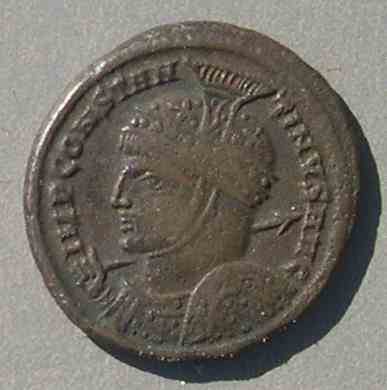

Constantine
struck 319
at Siscia
19 mm. 12:00
RIC Siscia 82, page 434, plate 13
mintmark: • ASIS •
O: IMP CONSTANTINVS AVG
bust left with spear and shield
crested, close-fitting helmet
possibly with crosses in the front and rear parts
It is not at all clear that those cross-like symbols are actually Christian symbols. Many coins of this basic type have helmets decorated with swirls or other symbols with no Christian connection. In my opinion, those are just helmet decorations and not Christian symbols.
Type 1.4; is distinguished by a chi-rho on the helmet, in the middle band of the helmet, above the ear

Note for collectors: This variety is extremely rare and highly sought after. A few years ago one was offered at $6000.
Type 1.5 is distinguished by a cross on the column.
Reverse: "Two Victories," VICTORIAE LAETAE PRINC PERP, two victories facing each other, holding shield inscribed VOT PR on column between them

Constantine
Struck 318-319 at Ticinum
18 mm. 2.74 grams. 6:00.
RIC Ticinum 86
VICTORIAE LAETAE PRINC PERP
Two victories facing each other, holding shield inscribed VOT PR on column between them
cross on the column
The cross, although only a small part of the design, looks very intentional with bold serifs.

Constantine
Struck 320 at London
19 mm. 3.32 grams. 6:00
RIC London 168
VICTORIAE LAETAE PRINC PERP
Two victories facing each other, holding shield inscribed VOT PR on column between them
cross on the column
This coin, from the London mint, has a "column" which looks much like a table and the cross is in a wreath and neither as bold nor as clearly intended to be a cross. It has no more detail than a plus (+) sign.
This is a very common type, rarely with a cross on the column. This "two Victories" type was minted for Constantine, Crispus, Licinius I and Licinius II with a wide variety of minor symbols on the column. Is the cross just one among a selection of meaningless control marks, or it genuinely a Christian reference? The cross on the first example is convincing and probably intentional. The "+" on the second one may or may not be a subtle Christian reference.
Note for Collectors: The variety with a bold cross is scarce, but is often available and usually does not bring a huge premium. It might cost three times the cost of an example without a cross.
Type 1.6 has a six-pointed star in the field left. It might be a monogram made from I (Jesus-- the Romans used I for our J) and X (Christus). Some think might just be a six-pointed star. The Christian reference of this type is not certain, but likely. Maurice (in Numismatique Constantinienne, volume I, page 323) says the Iota-Chi is the earliest Christian symbol found on Christian funerary monuments. Some, like the first one illustrated, have a bump at the top which usually seems to be centered, as opposed to the top of a "P". A clear chi-rho, if it exists, must be very rare. I know of two very experienced experts who have not seen one.

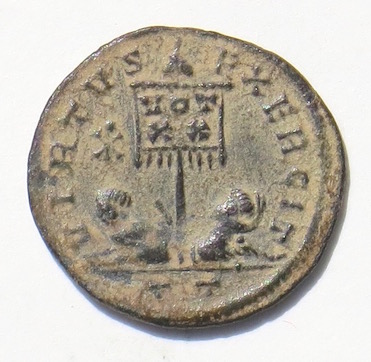
Constantine II
Struck 319-320 at Ticinum
19-18 mm. 2.05 grams. 5:30.
RIC Ticinum 121, page 377
Note the bump at the top of the Iota. It is not a rho, but
it is close enough to induce some scholars to write that
this type exists with a chi-rho. (See below for a line drawing.)


Constantine II
Struck 320 at Thessalonica
Mintmark: TSB •
19-18 mm. 2.76 grams. 12:00
RIC Thessalonica 83, page 508
Note that the top of the Chi-Iota does not have a bump
or any indication a Rho was intended.


Crispus, 317-326
Struck 320 at Aquileia
18 mm. 2.48 grams. 5:30.
Mintmark: AQΓ
RIC Aquileia 61


Licinius, 308-324
Struck 320 at Aquileia
18 mm. 2.62 grams. 11:30.
mm: AQS
RIC Aqulieia 59.
It is interesting that this Chi-Iota variety was issued for Licinius
who was clearly not Christian.
Here is a line drawing copied from an article on early Christian symbols on coins:

It is not certain that there really is a coin like this with a clear rho. If you have evidence it exists, please contact me. 
(By the way, no one has contacted me in the years since this has been on the web.)
Type 1.7 is distinguished by the entire reverse, which is unlike any other reverse in the entire Roman series.
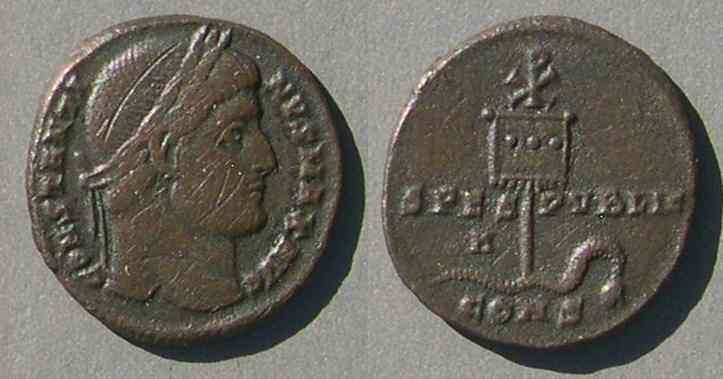
Constantine
Struck 326
at Constantinople
18 mm. 2.99 grams. 6:00
CONSTANTI-NVS MAX AVG
SPES PVBLIC across field, A in left field below
standard planted in snake/serpent with head curved down, three dots on vexillum, chi-rho above
Mintmark: CONS
RIC Constantinople 19, page 572, plate 18.19
This type is discussed on this page.
Note for collectors: This type is rare, seldom offered (and then usually in major auctions), of unique design, widely recognized as one of the very first Christian types, of great interest to scholars and collectors, and very expensive--often several thousand dollars. The scholar Humphrey Sutherland, author of "Roman Coins" said it is "the only purely and overtly Christian type [of Constantine]" (note 282 page 297). This type has been the subject of many scholarly and popular articles. (A web search will find some.)
Type 1.8 is distinguished by the chi-rho on the shield

Crispus
Struck 326
at Trier
19-17 mm. 6:00
IVL CRISPVS NOB CAES
BEATA TRANQVILLITAS
VO/TIS/XX on altar with globe on it
mintmark: •PTR•
RIC Trier 372 "c3" for type
a footnote cites this variety from the Hunter Collection
(the Hunter example is much more worn, but from the same obverse die)
This coin is ex Langtoft II hoard, coin 136.
I believe the chi-rho on the shield was struck only for Crispus, possibly from only this one die.
Note for collectors: This variety is excessively rare and the only variety to illustrate the chi-rho actually on the shield as Lactantius said occurred at the Battle of the Milvian Bridge. As such, it is extremely historical and highly desirable.
Type 1.9 is distinguished by a chi-rho between the two stars above the wolf.

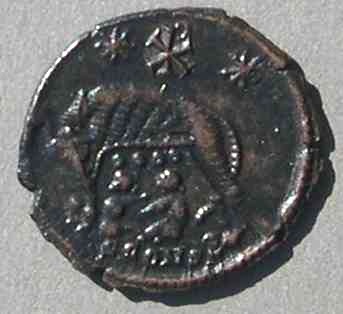
VRBS ROMA, struck 336 [RIC} or 335 [King]
at Arles
17 mm. 1.74 grams. 12:00
Mintmark: SCONST
wolf and twins, chi-rho between stars above
RIC Arles 385
This piece ex Bicester (Oxon) hoard.
C. E. King "The Bicester (Oxon) hoard of folles AD 317-348" #1745
Note for collectors: The VRBS ROMA type is extremely common, but this chi-rho variety occurs only at Arles (with SCONS... mintmark) and only on some examples from that mint. It is probably worth five times as much as a comparable example without the chi-rho.
Type 1.10 is disntiguished by a chi-rho in the left reverse field.

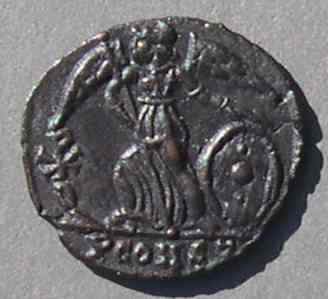
CONSTANTINOPOLIS, struck c. 334-336
at Arles
16-15 mm. 1.37 grams. 6:00
Helmeted, laureate bust of Constantinople left
Victory left with spread wings holding scepter and resting left hand on shield,
foot on small prow
chi-rho in field left
Mintmark: PCONST
RIC Arles 386 = 401.
Note for collectors: The CONSTANTINOPOLIS type is extremely common, but this chi-rho variety occurs only at Arles (with SCONS... mintmark) and only on some examples from that mint. It is probably worth five times as much as a comparable example without the chi-rho.
Type 1.11 is distinguished by a chi-rho high between the two standards.
GLORIA EXERCITVS
Two soldiers and two standards, with chi rho high between them.

Constantine
struck 334
at Arelate (Arles)
18 mm. 2.40 grams. 11:30.
CONSTANTI-NVS MAX AVG
GLORIA EXERCITVS
Two soldiers and two standards, with
chi rho between
Mintmark: PCONST
RIC Arles 381
Note for collectors: The GLORIA EXERCITVS type is extremely common, but this chi-rho variety occurs only at Arles (with SCONS... mintmark). Numerous examples have some symbol (a palm branch or a tree-like symbol) between the two standards, but a chi-rho between them is extremely rare.

Constantine II
struck 334
at Arlelate (Arles, as Constantina)
17-16 mm. 2.68 grams. 6:00.
CONSTANTI-NVS IVN NC
Two soldiers and two standards, with
chi rho between
Mintmark: PCONST
RIC Arles 382 "r5"form only this one officina.
Found in England.
(I have seen two more than RIC knew about, and there may be still more, but it is extremely rare.)
Type 1.12 is distinguished by a long cross low between the two standards.
GLORIA EXERCITVS
Two soldiers and two standards, with long cross low between them
Struck only at Aquileia
in the names of Constantine, Constantine II, and Constantius II

Constantine I
Struck 334-September 335
at Aquileia.
17 mm. 2.17 grams. 12:00.
CONSTANTI-NVS MAX AVG
GLOR-IA EXERC-ITVS
Mintmark: AQS
RIC Aquileia 124, page 407

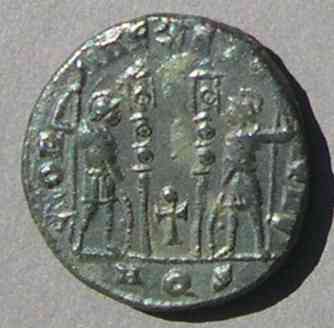
Constantine II
Struck 334 - Sept. 335
at Aquileia
16 mm. 2.81 grams. 6:00
CONSTANTINVS IVN NOB C
GLOR-IA EXERC-ITVS
Mintmark: AQS
RIC Aquileia 125, page 407

Constantius II
Struck 334 - Sept. 335
at Aquileia
18 mm. 2.42 grams. 12:00
FL IVL CONSTANTIVS NOB C
GLOR-IA EXERC-ITVS
Mintmark: AQP
RIC Aquileia 126, plate 12, p. 407
Note for collectors: The GLORIA EXERCITVS type is extremely common, but this long-cross variety occurs only at Aquileia. It is very rare and seldom offered (r3-r5 in RIC). It comands a significant premium (even though it is not well-known). I have seen more examples for Constantine II than the other rulers, but that may just be by chance.
Type 1.13 is distinguished by a large chi-rho on a single standard before the death of Constantine (as can be determined by the legends), only at Arelate. [Do not confuse this with the similar type (Type 2.1) from Siscia struck after the death of Constantine]
Reverse: Two soldiers, either side of one standard with chi rho on standard
Struck only at Constantina, the name at the time of the mint city now called Arelate (Arles).
Struck in the names of Constantine, Constantine II, Constans, Constantius II, and Delmatius.

Constantine
Struck 336
at Constantina = Arelate (Arles)
16 mm. 1.46 grams. 12:00.
CONSTANTI-NVS MAX AVG
GLORIA EXERCITVS
Two soldiers, either side of one standard with chi rho on standard
Mintmark: PCONST
RIC Arles 394P

Constantine II
Struck 335 as Caesar
at Constantina = Arelate
17 mm. 1.84 grams. 12:00
CONSTANTI-NVS IVN N C
GLOR-IA EXERC-ITVS
Two soldiers, either side of one standard with chi rho on standard
Mintmark: PCONST
RIC Arles 382, 395

Constantius II
struck 336 as Caesar
at Constantina (Arles)
16 mm. 1.33 grams. 12:00
FL IVL CONSTANTIVS NOB C
GLOR-IA EXERC-ITVS
Two soldiers either side of one standard with ch-rho on standard
Mintmark: PCONST
RIC Arles 396

Delmatius, Caesar 335-337
Struck 336
16 mm. 1.31 grams. 6:00
FL DELMATI-VS NOB CAES
GLOR-IA EXERC-ITVS
Two soldiers either side of one standard with ch-rho on standard
Mintmark: SCONST
RIC Arles 398, page 277
Note for collectors: The GLORIA EXERCITVS with one standard type is extremely common, and not unusual with a chi-rho on the standard. Be sure to distinguish this type struck at Arles (SCONST) before the death of Constantine from the later, similar, type from Siscia which is demonstrably struck after the death of Constantine (Type 2.1). It is scarce to rare. Nevertheless, it sometimes sells without much premium, perhaps because the difference is not well-known.
One more--an ancient imitation of the above type:

Constantine II, ancient imitation
15 mm. 1.71 grms. 6:00
CONSTANTINVS B C [sic]
-----A EXERC-ITVS
Two soldiers either side of one standard with ch-rho on standard
Mintmark: not bold, possibly CONSI, probably imitating PCONST
Prototype: RIC Arles 382, 395
Type 1.14 is distinguished by an "X" on the standard.
Reverse: Two soldiers, either side of one standard with X (St. Andrew's cross, possibly) on standard.
Struck only at Constantina, the name at the time of the mint city now called Arelate (Arles).

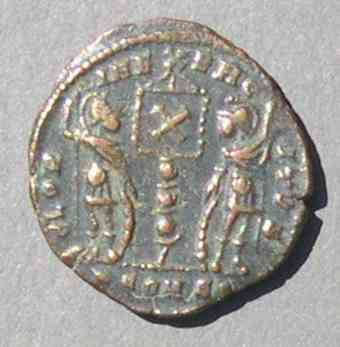
Constantine II
Struck 336-7 as Caesar
17 mm. 1.45 grams. 6:30
CONSTANTI-NVS IVN N C
GLOR-IA EXERC-ITVS
Two soldiers either side of one standard with X (St. Andrew's cross, possibly)
Mintmark: PCONSS (or T?)
RIC Arles 403 "r5"
Note for collectors: The GLORIA EXERCITVS with one standard type is extremely common. This variety, only from Arles, with an "X" on the standard is very rare, but not certainly "Christian," although Arles is associated with other symbols likely to be Christian. If this variety is Christian, it is too obscure to have garnered much attention.
Type 1.15 is distinguished by the head's tilt backwards which allows him to look upwards towards heaven.

Constantine
Struck 328
19 mm. 3.16 grams. 6:00.
Reverse: CONSTANTINIANA DAFNE
Victory seated left, head right "eyes to heaven"
captive to left below, trophy in field
Mintmark: CONS, B in left field
RIC Constantinople 32
There is no Christian "symbol" on this type, but the "eyes to heaven" head is new at this time period and recognized in antiquity as related to Christianity.
This type is worthy of discussion in two distinct ways. The "eyes to heaven" look is remarkable and has Christian reference, and the reverse type referencing DAFNE is unique to Constantine.
[This discussion will be greatly extended when I find the time. It is on my to-do list.]
The "eyes to heaven" obverse is most common with the DAFNE reverse, but also appears with a "VOT/XXX" reverse:


Constantine
Struck 325-326
18 mm. 2.55 grams. 12:00
Reverse: VOT/XXX in wreath
DN CONSTANTINI MAX AVG around
RIC Heraclea 72v (officina Gamma unlisted)
Continue with Table 2 (coins of AD 337-340)
Return to the main page.

 Constantine, 307-337
Constantine, 307-337




































